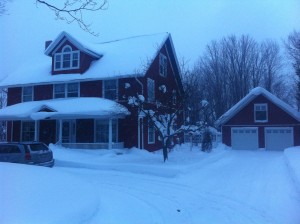
Kurtti House.
It’s a long haul from Duluth to the Keweenaw Peninsula of Upper Michigan. My blue Pacifica is loaded with copies of Suomalaiset: People of the Marsh and Sukulaiaset: The Kindred. As always, I’m cautiously optimistic that I’ll sell every copy of my books I’m bringing with. That, of course, has never happened. Still, as a semi-famous self-published author of historical novels about the Finns headed towards the heart of Finnishness in America, I’m eternally hopeful.
The Pacifica’s tires slap blacktop as I wind my way from Duluth to Ashland. It’s a cold wintery day, below zero. I stop to fill up the car at a Holiday statio and as I stand in the brisk air, listening to the gurgle of fuel entering the gas tank, I look around and smile.
I wrote about Ashland once, in Esther’s Race, as the place where Esther DuMont’s grandmother lived. Esther’s dad, Dr. DuMont, worked at the hospital here. Didn’t sell many copies of that book. Still, it’s a good place to set a yarn…
The snow pack increases near the Michigan line. My neck of the woods, north of Duluth on the banks of the Cloquet River, is a virtual winter desert: the ground is nearly devoid of snow. Entering the South Shore’s snow belt, I see trailers of snowmobiles being pulled by pickups and SUVs, their owners heading east in search of snow. I enter Michigan, turn north at Bruce Crossing, but see no wildlife; no deer or grouse or rabbits or any wild critter as the tires of the Pacifica hum.
“I’m watching you back into my neighbor’s driveway,” my host for the weekend, Jim Kurtti, says when I call him from my cell phone. “It’s the big red house next door.”
Jim, who is both the editor of the Finnish American Reporter and the director of the Finnish American Heritage Center housed at Finlandia University in Hancock, Michigan greets me at the front door. I haul my suitcase into the parlor of an immaculate Victorian, the hardwood floors gleaming beneath antique light fixtures aglow against the dusk.
“You guys have a lot more snow than we do,” I say, offering my hand to Jim.
“Always.”
He shows me to a lovely bedroom on the second floor, the space that’ll be my home for the next two nights.
This place could easily be a B&B.
Jim’s wife Debbie returns home from work with a pizza from a local eatery. Jim and I are already settled in, drinking sweet Italian wine, and talking writing, books, politics, Keweenaw history, and religion when Debbie arrives. A neighbor lady joins us as we scarf very good pizza at the kitchen table. Afterwards, Jim and I take sauna and the talk continues. It’s the second time we’ve saunaed together, having met in the sauna bath at Sampo Beach north of Duluth some years back when Jim was in town to profile a group of local Finns who were reading Suomalaist for their Finnish American book club.
Saturday. By the time I wake up, shower, shave, and dress, the Kurttis are gone, already at Heikinpaiva, the winter festival at Finlandia University that I am participating in. I’m scheduled to be at North Wind Books, the campus bookstore, from 10-4, with a break at 2 to give a talk at the Finnish American Institute. On my way into town, I grab breakfast at McDonald’s. I arrive at the bookstore on time. Alana, the store manager, greets me with a smile. “Did you bring more copies of Sukulaiset with you? These two are the only copies I have.”
“I did. I’ll bring some in.”
For the next four hours, I chat with Alana and the student/clerk working the store. I meet customers and sell books to strangers. I am pleasantly surprised when Dave and Peggy Radovich, formerly of Hermantown and friends, make good on their Facebook promise to visit me. “I thought you were Croatian,” I say to Dave as Peggy buys a copy of Suomalaiset. “A quarter. Three-quarters Finn.” Dave is originally from the UP and the retired educator has returned to his roots. Except the former principal was asked by Bessemer to fill a superintendency, which means he is, I guess, unretired.
To stretch my legs, I go outside and watch the Heikinpaiva parade working its way past the Heritage Center.
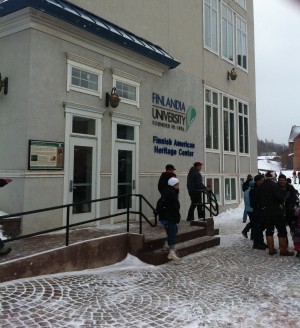
Finnish American Heritage Center, Hancock.
Two o’clock comes quickly. The crowd at the lecture is a bit thin. I’d hoped for a full house but that’s not what transpires. Still, as I read passages from my books, talk a bit about my writing process and the impetus behind a non-Finn’s fascination with Finnish history, and answer questions, I’m engaged with my slender audience. Alana sells some books, I sign some books, and then it’s back to the bookstore for another hour of sitting and selling. I meet a German immigrant woman who’s interested in my take on the relationship between Mannerheim and Hitler. She buys a copy of Sukulaiset. Alana has me bring in a few more copies of my books. I sign them for the store.
“I’ll just email you an invoice,” I say as I head out the door, our business conducted casually, as if by handshake. “Thanks for having me.”

Monument to a giant.
I stop outside the bookstore to admire an obelisk erected in memory of a local legend, a giant Finn who once lived in the Keweenaw. With time to kill (Jim and Deb are tied up with festival duties and I don’t know anyone else in town)
I decide to visit Calumet, a few miles north of Hancock. One of my former law clerks, Heidi Murtonen, is from Calumet. That fact and the rumors I’ve heard about a gorgeous old theater, still active and in use, located in the little town
prompt me to put the Pacifica in gear and climb the hill behind Finlandia. I end up in Calumet where I drive up and down the snowy, quaint downtown marveling at what the town must have been like in its heyday.
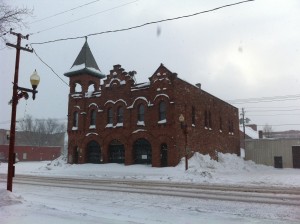
Fire hall, Calumet
I take the long way back to the Kurttis’ and find myself only a block from their palatial home and smack dab in the ruins of an old copper mine. I stop the car and stand in the omnipresent lake effect snow that is waltzing down from the leaden sky to
snap photos of a life long passed.
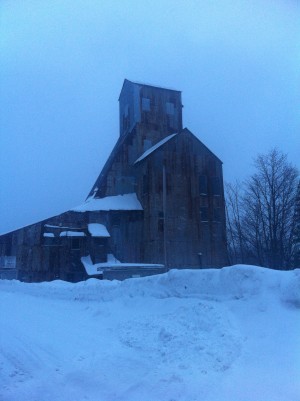
I mull over getting something to eat. On a whim, I decide to attend the Heikinpaiva dance scheduled for the
Heritage Center that evening. I drive back into Hancock, snow drifting over the lighted valley as I cross the lift bridge between Houghton and Hancock, park the Pacifica, and eye a well-lighted eatery across the street.
Italian sounds good.
I climb the steps to the social hall of the Finnish American Heritage Center, a deconsecrated Catholic church renovated to a new purpose, and find out that the dance includes a meal and libations, all for the very reasonable fee of ten bucks.
I buy a ticket, hang up my coat, and enter the hall. I find Jim and Debbie and soon I’m immersed in the sounds of Finnish folk music and watching adults and children dance across the luminously polished hardwood floor.
I snap a few pictures of the dancers and post them on line. My wife texts me and asks me where I am. I tell her I’m at a dance at the Heritage Center.
“Just don’t be dancing with any Finnish girls,” she writes. “There’s a French girl waiting for you at home!”
I promise to behave. I eat heartily of the Finnish foods and desserts that cover the buffet table. I sip a local beer and meet new friends. Tired after a day of selling and talking and observing, I say my goodnights and drive back to the Kurttis’ home.
Sunday morning, I take a hot shower and pack. The Kurttis are already at church. I write a short note of thanks, load my car, and head on back down the road, happy to have spent a few days immersed in another place, another culture.
Peace.
Mark
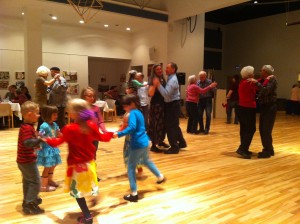
The dance.
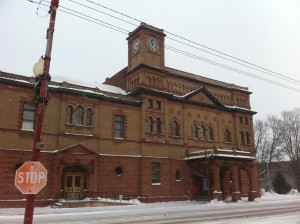
Theater, Calumet.


